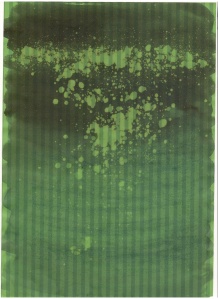[Gunpowder: 75% potassium nitrate 15% carbon (charcoal) 10% sulphur]
Matthew Tosh kicked off the session by lighting a sparkler – perhaps the simplest of fireworks and the most mesmerising but, as Matthew pointed out, the one that causes the most accidents (it is white hot at its centre and three sparklers together would be hot enough to weld metal). This familiar act of lighting and burning a sparkler illustrated the way fireworks present a series of dichotomies: they are simultaneously powerful and fleeting; industrial and beautiful.
Matthew’s demonstration quickly brought home to me the fact that fireworks are far more than a visual experience. In anticipating the workshop, I had been imagining the colourful blooms one sees in the sky, but sitting in the Institute of Making, it was the sounds, smells and tastes of explosions that were foregrounded. The names of some fireworks refer to the way their exploding shapes mimic flowers and petals – ‘chrysanthemum’, ‘dahlia’, ‘peony’ – but their other effects are far from floral, they are the smoke, the bang, the flickering of light – fireworks bloom and fade in an instant, but noisily so. One sensory experience that I do not associate with fireworks – usually seeing them from a freezing park in November – is warmth. But as Matthew set off a flare – it was the blast of heat more than the light that hit you.
Glowing, fizzing, roaring, coloured flashes of light and discharges of smoke rattled about the Institute of Making – Matthew spoke about the different effects he can achieve with metals, different sizes of container, oxidisers; strontium for red; sodium for yellow; copper salt for blue.
As I write this, I am sitting in the Library at Winterthur in the US – an estate owned by the du Pont family who first made their fortune in the sale of ‘black powder’. In the wooded country of Brandywine Valley in this eastern corner of America, du Pont built his Powder Mills and used the recipe for gunpowder that he had brought with him from France – where he had trained under the famous chemist, Antoine Lavoisier. The du Pont recipe was put to use in the war with the British (1812-15), the Civil War (1861-5), and the First World War. It was also used for blasting coal mines, building canals, roads, and railroads. Looking around me, at the estate, the ornamental gardens, the vast collections or art and artefacts – it is clear that this black powder was big business.
Artist Lucy Lyons helped us in our response to Matthew’s demonstration. Lucy’s work focuses on how life is transformed into death; anatomy into pathology; how the body is transformed into a medical specimen. She uses drawing to get through the unfamiliar or the shocking in order to understand something in detail, through close looking. She hopes to re-see things as she draws them. But Lucy asked us to recognise the non-visual, experiential effects of fireworks – put our shock at a sudden crack of ‘flash powder’ onto the page. This made me wonder how we can understand these non-visual experiences in the past?
Returning to the questions I thought about during our first workshop on Emotions, I felt that this close sensory experience of fireworks – focused on their chemistry and non-visual manifestations – would help me to understand them differently as I see them in the sky on bonfire night. I thought also, that it would help me detect what might be missing in historical sources on episodes of fantastic visual display – an acknowledgment of the accompanying sensations, sounds and smells that root them in the memory. It also brought home to me that a detailed understanding of the chemistry behind the explosion re-doubles one’s reverence for the power of materials – materials in very particular compositions – and heightens the anticipation of thunder and blossom.
